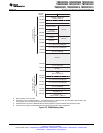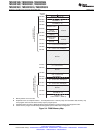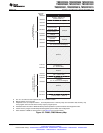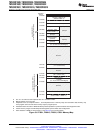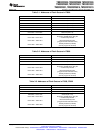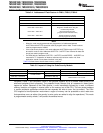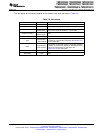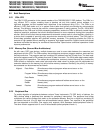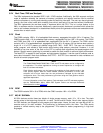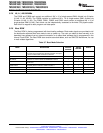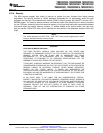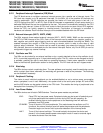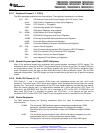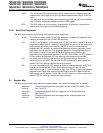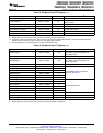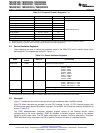
TMS320F2809, TMS320F2808, TMS320F2806
TMS320F2802, TMS320F2801, TMS320C2802
TMS320C2801, TMS320F28016, TMS320F28015
www.ti.com
SPRS230L–OCTOBER 2003–REVISED DECEMBER 2009
3.2.4 Real-Time JTAG and Analysis
The 280x implements the standard IEEE 1149.1 JTAG interface. Additionally, the 280x supports real-time
mode of operation whereby the contents of memory, peripheral and register locations can be modified
while the processor is running and executing code and servicing interrupts. The user can also single step
through non-time critical code while enabling time-critical interrupts to be serviced without interference.
The 280x implements the real-time mode in hardware within the CPU. This is a unique feature to the
280x, no software monitor is required. Additionally, special analysis hardware is provided which allows the
user to set hardware breakpoint or data/address watch-points and generate various user-selectable break
events when a match occurs.
3.2.5 Flash
The F2809 contains 128K x 16 of embedded flash memory, segregated into eight 16K x 16 sectors. The
F2808 contains 64K x 16 of embedded flash memory, segregated into four 16K x 16 sectors. The F2806
and F2802 have 32K x 16 of embedded flash, segregated into four 8K x 16 sectors. The F2801 device
contains 16K x 16 of embedded flash, segregated into four 4K x 16 sectors. All five devices also contain a
single 1K x 16 of OTP memory at address range 0x3D 7800 – 0x3D 7BFF. The user can individually
erase, program, and validate a flash sector while leaving other sectors untouched. However, it is not
possible to use one sector of the flash or the OTP to execute flash algorithms that erase/program other
sectors. Special memory pipelining is provided to enable the flash module to achieve higher performance.
The flash/OTP is mapped to both program and data space; therefore, it can be used to execute code or
store data information. Note that addresses 0x3F7FF0 – 0x3F7FF5 are reserved for data variables and
should not contain program code.
NOTE
The F2809/F2808/F2806/F2802/F2801 Flash and OTP wait-states can be configured by
the application. This allows applications running at slower frequencies to configure the
flash to use fewer wait-states.
Flash effective performance can be improved by enabling the flash pipeline mode in the
Flash options register. With this mode enabled, effective performance of linear code
execution will be much faster than the raw performance indicated by the wait-state
configuration alone. The exact performance gain when using the Flash pipeline mode is
application-dependent.
For more information on the Flash options, Flash wait-state, and OTP wait-state registers,
see the TMS320x280x, 2801x, 2804x DSP System Control and Interrupts Reference
Guide (literature number SPRU712).
3.2.6 ROM
The C2802 contains 32K x 16 of ROM, while the C2801 contains 16K x 16 of ROM.
3.2.7 M0, M1 SARAMs
All 280x devices contain these two blocks of single access memory, each 1K x 16 in size. The stack
pointer points to the beginning of block M1 on reset. The M0 and M1 blocks, like all other memory blocks
on C28x devices, are mapped to both program and data space. Hence, the user can use M0 and M1 to
execute code or for data variables. The partitioning is performed within the linker. The C28x device
presents a unified memory map to the programmer. This makes for easier programming in high-level
languages.
Copyright © 2003–2009, Texas Instruments Incorporated Functional Overview 35
Submit Documentation Feedback
Product Folder Link(s): TMS320F2809 TMS320F2808 TMS320F2806 TMS320F2802 TMS320F2801 TMS320C2802
TMS320C2801 TMS320F28016 TMS320F28015



